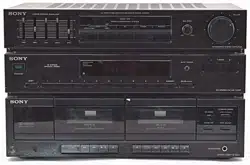#4 PROTECT or PROTECTOR is flashing in the display of the home
audio device.
If the words PROTECTOR and PUSH POWER appear in
alternating sequence on the display of your home audio device,
or if the word PROTECT or PROTECTOR appears, there may be
an external speaker issue or connection issue that is triggering
the protection circuit. Try following these steps to resolve this
issue:
NOTE: Because each of these steps represents a possible
solution to this issue, check the A/V receiver status after
completing each step.
If there has been an electrical surge or power outage, then the
internal surge protection inside the home audio device may
have been triggered to protect the device from the surge. This is
normal. To reset the internal surge protection circuit unplug the
AC power cord from the wall for at least 30 minutes.
Ensure the top of the home audio device has proper ventilation
to keep it from overheating. Running the home audio device in a
poorly ventilated cabinet can trigger the protection circuit.
Reduce the volume level. If the impedance of any of the
speakers is below the rated impedance range indicated on the
rear of the home audio device next to the speaker connections,
the home audio device may enter the PROTECT mode. Raising
the volume with a low impedance speaker will trigger the
protection circuit.
NOTES:
Replace low impedance (outside of specifications) speakers
with the correct impedance to prevent this from occurring.
If you continue to use the low impedance (outside of
specifications) speakers and you ran the Auto Calibration, check
your SPEAKER SETUP and individual speaker LEVEL to reduce
any speaker LEVEL with a positive gain to 0.0dB or less.
To isolate the problem, do the following:
Turn off the home audio device, and remove all speaker wires
from the back. Then turn the device back on and check if the
issue is resolved. If it is still having the same issue, turn off the
device again leave it off for at least 30 minutes before turning it
on again.
Inspect the speaker cords. If a cord is frayed or in contact with
another terminal, an error will occur. Fix the connection to
prevent a short circuit.
Make sure the speaker impedance is within the recommended
range. If the impedance is not correct, the speakers will not
work properly and may be damaged. If the speakers are within
the recommended impedance range, check the connections. If
the speakers being used are within the suitable impedance
range and they are still not working, there may be a malfunction
or some other flaw within the speakers. Test by using a different
set of speakers if available.


